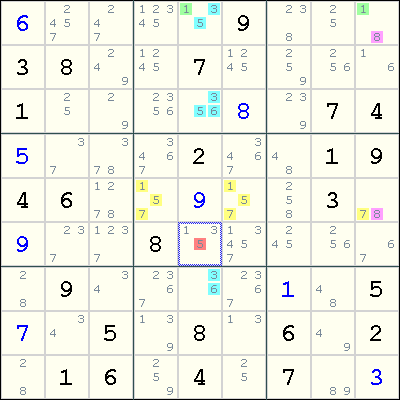PIsaacson wrote:The following is from the solution log for Royle17 #40:
- Code: Select all
Royle17 #40 after simple eliminations:
8 B27-9 A29 |4 6 3 |79 1 5
A46 B457-6 57-6 |9 1 2 |67 8 3
3 AB69 1 |7 8 5 |69 4 2
--------- --------- ---------+--------- --------- ---------+--------- --------- ---------
7 8 4 |2 5 6 |3 9 1
9 B56 56 |1 3 7 |4 2 8
1 23 23 |8 9 4 |5 7 6
--------- --------- ---------+--------- --------- ---------+--------- --------- ---------
5 B79 8 |6 4 1 |2 3 79
2 34-9 39 |5 7 8 |1 6 49
46 1 67 |3 2 9 |8 5 47
do_alschains - graph contains 104 vertices and 1388 edges
do_alschains - reducing r2c2.<4567> by <6> dual
do_alschains - reducing r2c3.<567> by <6> dual
do_alschains - reducing r1c2.<279> by <9> dual
do_alschains - reducing r8c2.<349> by <9> dual
do_alschains - sdc+c[2x6/6] b1x348.<2469> +24+ r12357c2.<245679>
Not an SDC, but truly a bizzare dual-linked overlapping, cannibalistic dual-linked ALS. I can't explain the candidate eliminations is terms of subset counting, especially the r1c2 <> 9 and r2c2 <> 6, but these types of ALSs are "all over the place" and all the eliminations are valid. Another example:
Your deduction is just overlapping ALS's where the two restricted common digits (2&4) are not part of the overlap. This is not CoALS, but rather just an ALS loop.
The AIC using ALS's for this deduction would be something like
(4&5&6&7&9=2)r12357c2 - (2=6&9&4)r1c3|r2c1|r3c2 - (4=2&5&6&7&9)r12357c2...AIC-loop
When ALS's are in an AIC loop, any digits in the ALS which do not have a weak link in the loop must be a part of that ALS. Thus the endpoints tell us that 5679 must be in B, and we also know that 6&9 must be in A. We can see this more easily if we cut the AIC-loop so that the endpoints are part of ALS 'A'.
(2&6&9=4)A - (4=5&6&7&9&2)B - (2=4&6&9)A...AIC-loop
Here it is easy to see the reason for the so-called cannibalistic deduction.
As Ron pointed out, there is also a hidden or AHS version of the deduction which might be easier to find. Noting that the 3's are locked in r68c2 while 5&7 are locked in r12c2|r2c3, we also have
(2&3)r2c68 = (2&5&7-5&7&4)r12c2|r2c3 = (4&3)r2c68...AIC-Loop
This loop implies that any digits not shown cannot exist in r1268c2|r2c3
CoALS would tell you that either 6&9 must exist in the combined A&B cells, or that 2&4&5&7 must exist in those same cells. If there was some cell or set if cells which prevented one of those premises from being true then you would know that the other premise was true. Generally this is just a quick check for certain examples of subset counting. As an slightly better example that could lead to a deduction, if we had
- Code: Select all
8 27 A29 |4 6 3 |79 1 5
A46 457-6 57-6 |9 1 2 |67 8 3
3 AB69 1 |7 8 5 |69 4 2
--------- --------- ---------+--------- --------- ---------+--------- --------- ---------
7 8 4 |2 5 6 |3 9 1
9 56 56 |1 3 7 |4 2 8
1 23 23 |8 9 4 |5 7 6
--------- --------- ---------+--------- --------- ---------+--------- --------- ---------
5 B79 8 |6 4 1 |2 3 79
2 34 39 |5 7 8 |1 6 49
46 1 67 |3 2 9 |8 5 47
We could form the intersecting A & B ALS's as shown. Then either 6&9 or 2&4&7 (or both) are true in cells marked with A and/or B. Since r1c2 contains only 27 and it sees all the 2's and 7's in A+B we know that it must be true that A+B contains 6&9 and we could elminate the 6 in r2c2. Usually there will be a simpler way than CoALS to make a deduction, but every now and then there isn't. Note also that CoALS requires at least 3 elements to make its deduction--the combined intersecting pair of ALS's and the cell or set of cells which eliminates one of the options (or at least weakly links to one of the options).
[edited to add second removal of a candidate in the diagram]



